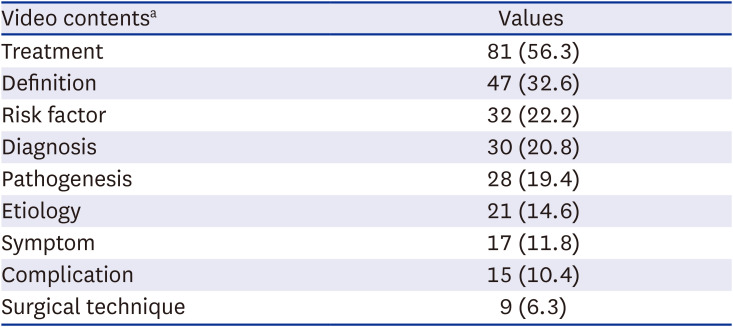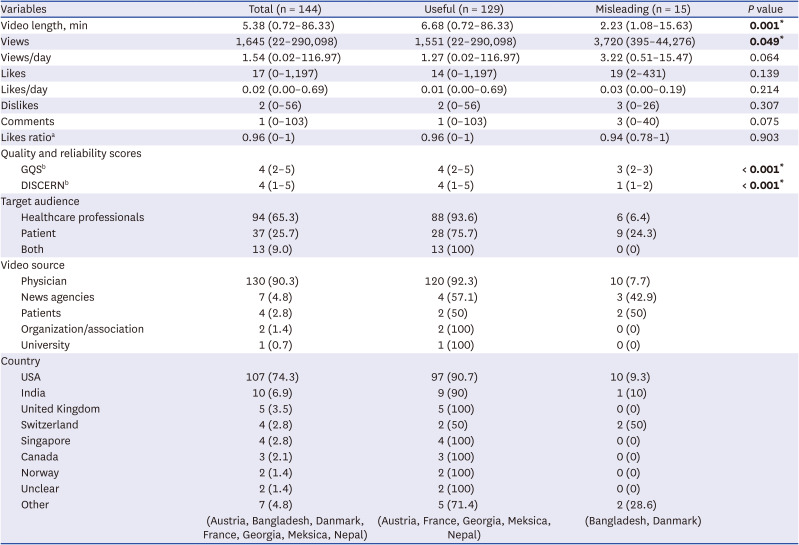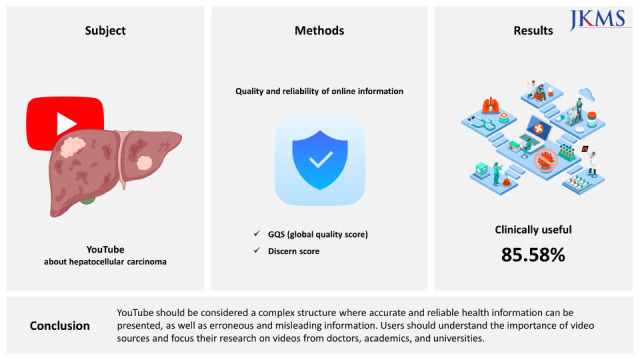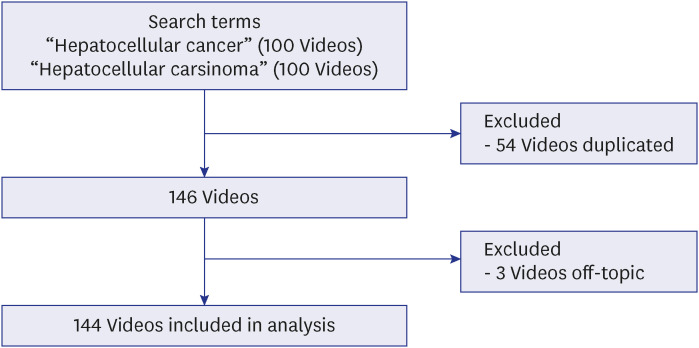1. Gilles H, Garbutt T, Landrum J. Hepatocellular carcinoma. Crit Care Nurs Clin North Am. 2022; 34(3):289–301. PMID:
36049848.

2. Madihi S, Syed H, Lazar F, Zyad A, Benani A. A systematic review of the current hepatitis B viral infection and hepatocellular carcinoma situation in mediterranean countries. BioMed Res Int. 2020; 2020:7027169. PMID:
32626758.

3. Hong YM, Yoon KT, Cho M, Kang DH, Kim HW, Choi CW, et al. Trends and patterns of hepatocellular carcinoma treatment in Korea. J Korean Med Sci. 2016; 31(3):403–409. PMID:
26955241.

4. Velasco E, Agheneza T, Denecke K, Kirchner G, Eckmanns T. Social media and internet-based data in global systems for public health surveillance: a systematic review. Milbank Q. 2014; 92(1):7–33. PMID:
24597553.

5. Madathil KC, Rivera-Rodriguez AJ, Greenstein JS, Gramopadhye AK. Healthcare information on YouTube: a systematic review. Health Informatics J. 2015; 21(3):173–194. PMID:
24670899.

6. Zimba O, Gasparyan AY. Social media platforms: a primer for researchers. Reumatologia. 2021; 59(2):68–72. PMID:
33976459.
7. Nibha S, Sharma A. Analysis of the most viewed Hindi YouTube videos on breast cancer. Indian J Cancer. 2022.
8. Laforet PE, Yalamanchili B, Hillyer GC, Basch CH. YouTube as an information source on BRCA mutations: implications for patients and professionals. J Community Genet. 2022; 13(2):257–262. PMID:
35023041.

9. Jansen BJ, Spink A. In : Arabnia HR, Mun Y, editors. An analysis of web documents retrieved and viewed. Proceedings of the International Conference on Internet Computing, IC 03; 2003 June 23-26; Las Vegas, NV. p. 65–69.
10. Bernard A, Langille M, Hughes S, Rose C, Leddin D, Veldhuyzen van Zanten S. A systematic review of patient inflammatory bowel disease information resources on the World Wide Web. Am J Gastroenterol. 2007; 102(9):2070–2077. PMID:
17511753.

11. Kocyigit BF, Akaltun MS, Sahin AR. YouTube as a source of information on COVID-19 and rheumatic disease link. Clin Rheumatol. 2020; 39(7):2049–2054. PMID:
32447603.

12. Şahin M, Kaya E. Understandability and actionability of education materials about syphilis on YouTube. Sex Res Soc Policy. 2022; 19(4):1989–1995.
13. Kaya E, Solak Y, Koçyiğit BF. YouTube as a source of information about gonorrhea. Cent Asian J Med Hypotheses Ethics. 2022; 3(2):103–110.

14. Singh AG, Singh S, Singh PP. YouTube for information on rheumatoid arthritis--a wakeup call? J Rheumatol. 2012; 39(5):899–903. PMID:
22467934.

15. Wasserman M, Baxter NN, Rosen B, Burnstein M, Halverson AL. Systematic review of internet patient information on colorectal cancer surgery. Dis Colon Rectum. 2014; 57(1):64–69. PMID:
24316947.

16. Loeb S, Reines K, Abu-Salha Y, French W, Butaney M, Macaluso JN Jr, et al. Quality of bladder cancer information on YouTube. Eur Urol. 2021; 79(1):56–59. PMID:
33010986.
17. Chou WY, Hunt Y, Folkers A, Augustson E. Cancer survivorship in the age of YouTube and social media: a narrative analysis. J Med Internet Res. 2011; 13(1):e7. PMID:
21247864.

18. Carneiro B, Dizon DS. Prostate cancer social media: in YouTube we trust? Eur Urol. 2019; 75(4):568–569. PMID:
30639141.

19. Desai T, Shariff A, Dhingra V, Minhas D, Eure M, Kats M. Is content really king? an objective analysis of the public’s response to medical videos on YouTube. PLoS One. 2013; 8(12):e82469. PMID:
24367517.
20. Sechrest RC. The internet and the physician-patient relationship. Clin Orthop Relat Res. 2010; 468(10):2566–2571. PMID:
20574803.
21. Drozd B, Couvillon E, Suarez A. Medical YouTube videos and methods of evaluation: literature review. JMIR Med Educ. 2018; 4(1):e3. PMID:
29434018.
22. Ferlay J, Shin HR, Bray F, Forman D, Mathers C, Parkin DM. Estimates of worldwide burden of cancer in 2008: GLOBOCAN 2008. Int J Cancer. 2010; 127(12):2893–2917. PMID:
21351269.
23. Axelrod DA, van Leeuwen DJ. Hepatocellular carcinoma. Medscape;2008.
24. John S, Broggio J. Cancer survival in England: national estimates for patients followed up to 2017. Newport, UK: Office for National Statistics;2019.
25. Neal RD, Tharmanathan P, France B, Din NU, Cotton S, Fallon-Ferguson J, et al. Is increased time to diagnosis and treatment in symptomatic cancer associated with poorer outcomes? systematic review. Br J Cancer. 2015; 112 Suppl 1(Suppl 1):S92–107. PMID:
25734382.
26. de Lope CR, Tremosini S, Forner A, Reig M, Bruix J. Management of HCC. J Hepatol. 2012; 56(Suppl 1):S75–S87. PMID:
22300468.
27. Tsuchiya N, Sawada Y, Endo I, Saito K, Uemura Y, Nakatsura T. Biomarkers for the early diagnosis of hepatocellular carcinoma. World J Gastroenterol. 2015; 21(37):10573–10583. PMID:
26457017.
28. Basch CH, Kecojevic A, Berdnik A, Cadorett V, Basch CE. An analysis of widely viewed YouTube videos on anal cancer. Int J Prev Med. 2017; 8:74. PMID:
29026506.
29. Kumar N, Pandey A, Venkatraman A, Garg N. Are video sharing web sites a useful source of information on hypertension? J Am Soc Hypertens. 2014; 8(7):481–490. PMID:
25064770.
30. Duran MB, Kizilkan Y. Quality analysis of testicular cancer videos on YouTube. Andrologia. 2021; 53(8):e14118. PMID:
34009641.

31. Pons-Fuster E, Ruiz Roca J, Tvarijonaviciute A, López-Jornet P. YouTube information about diabetes and oral healthcare. Odontology. 2020; 108(1):84–90. PMID:
31396751.
32. Koo BS, Kim D, Jun JB. Reliability and quality of Korean YouTube videos for education regarding gout. J Korean Med Sci. 2021; 36(45):e303. PMID:
34811977.
33. Basnet B, Bhattarai S, Khanal A, Upadhyay M, Baruwal A. Quality of YouTube patient information on prostate cancer screening. Proc Bayl Univ Med Cent. 2019; 32(3):361–363. PMID:
31384187.

34. Monto A, Wright TL. The epidemiology and prevention of hepatocellular carcinoma. Semin Oncol. 2001; 28(5):441–449. PMID:
11685737.
35. Samuel N, Alotaibi NM, Lozano AM. YouTube as a source of information on neurosurgery. World Neurosurg. 2017; 105:394–398. PMID:
28599904.

36. Chen Z, Zhu H, Zhao W, Guo H, Zhou C, Shen J, et al. Estimating the quality of YouTube videos on pulmonary lobectomy. J Thorac Dis. 2019; 11(9):4000–4004. PMID:
31656674.
37. Tackett S, Slinn K, Marshall T, Gaglani S, Waldman V, Desai R. Medical education videos for the world: an analysis of viewing patterns for a YouTube channel. Acad Med. 2018; 93(8):1150–1156. PMID:
29298180.






 PDF
PDF Citation
Citation Print
Print





 XML Download
XML Download